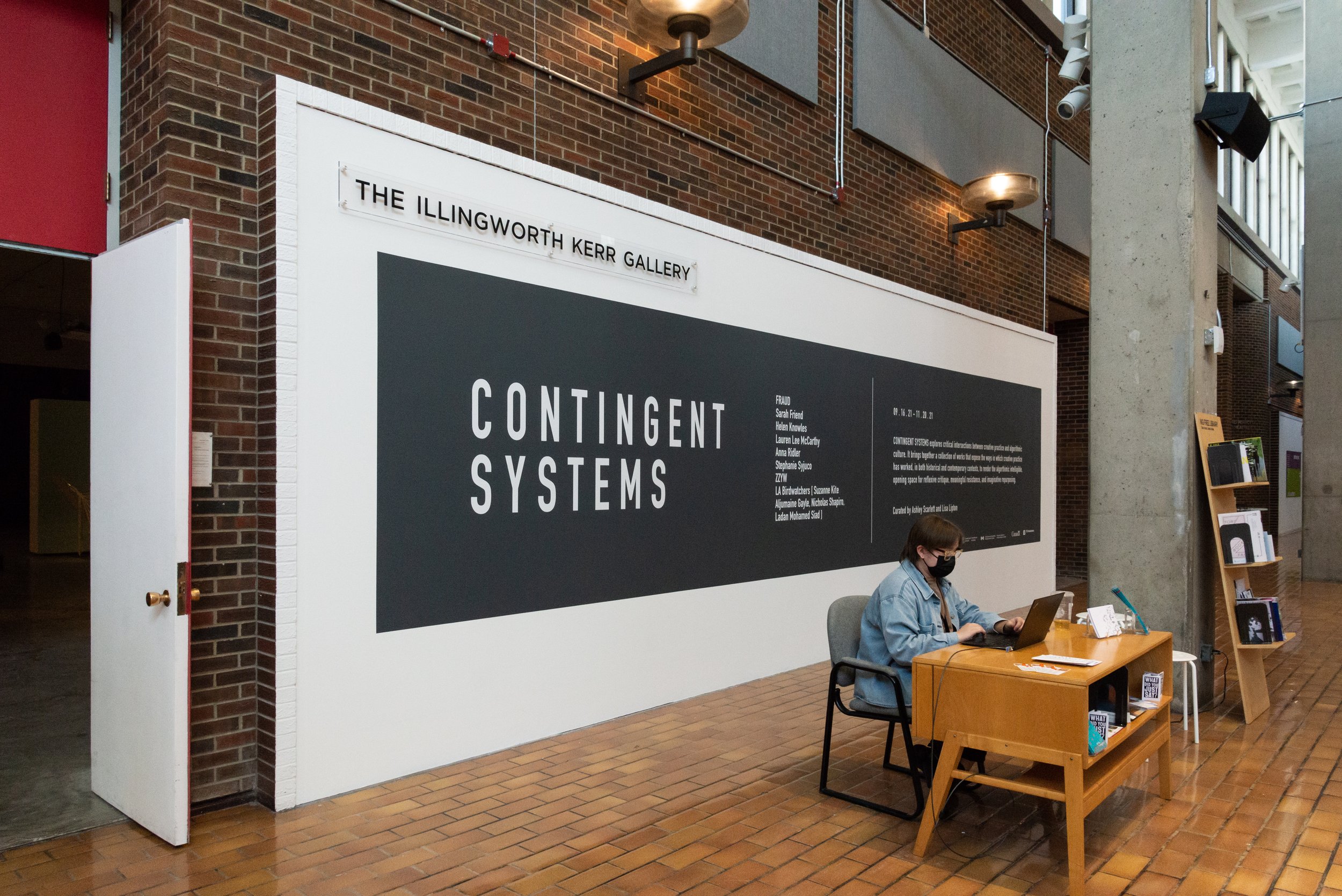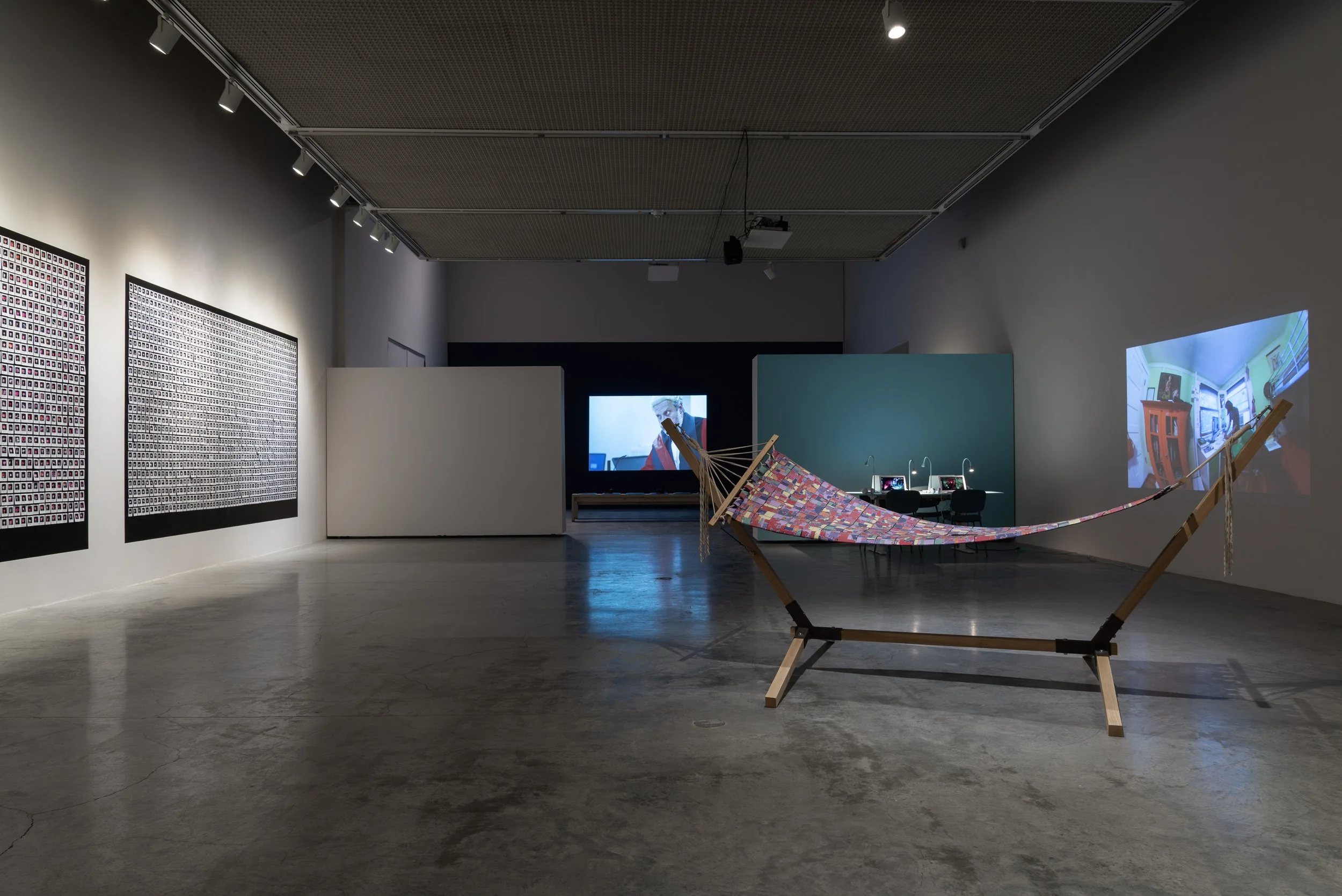

















CONTINGENT SYSTEMS: ART AND/AS ALGORITHMIC CRITIQUE
Ashley Scarlett & Lisa Lipton
Contingent Systems: Art and/as Algorithmic Critique is comprised of an exhibition, symposium, and set of forthcoming publications that explore critical intersections between creative practice and algorithmic culture. It brings together a collection of artworks and research presentations to expose how creative practice has worked, in both historical and contemporary contexts, to render the algorithmic intelligible, opening space for reflexive critique, meaningful resistance, and imaginative repurposing.
Participants include: Clemens Apprich, Aileen Bahmanipour, Bill Balaskas, Alex Borkowski, Susan Cahill, Crystal Chokshi, Michael Masaru Flora, FRAUD (Audrey Samson & Francisco Gallardo), Sarah Friend, Mél Hogan, Helen Knowles, LA Birdwatchers (Suzanne Kite, Aljumaine Gayle, Ladan Mohamed Siad, Nicholas Shapiro), Godfre Leung, Adam Lauder, Halcyon Lawrence, Lauren Lee McCarthy, Nicolas Malevé, Felipe Rivas San Martín, Tyriq Plummer, Anna Ridler, Constanza Salazar, Remy Siu, Stephanie Syjuco, Pip Thornton, Martin Zeilinger, ZZYW (Zhenzhen Qi & Yang Wang).
This project responds to recent calls for a demystification of the algorithmic undercurrents of contemporary culture (Crawford 2021; Benjamin 2019). While in technical terms algorithms are simply instructions that enable the automated operation of computational technologies, within the contemporary context they have become generative ‘culture machines’ (Finn 2017). Working as invisible engines that sort, rank and instrumentalize massive amounts of environmental, biometric and behavioral data (Hallinan & Striphas 2016: 119), algorithmic technologies are increasingly responsible for enabling and pre-emptively choreographing many of the practices that comprise our everyday lives (Hansen 2015). While countless scholars have identified the troubling consequences that algorithmic systems pose for racialized, gendered, sexualized, classed and labouring subjects (e.g., Noble 2018; Bucher 2018; Browne 2015; Chamayou 2015), developing strategies of resistance has been complicated by the seeming impossibility of fully grasping, critiquing, escaping, or countering algorithmic operations (Zuboff 2018); unfolding outside of the phenomenal field of human experience (Zielinski 2008), they are simply too small, too fast, and too expansive for people to grasp directly or comprehend exhaustively (Henning 2018).
Although scholars have readily identified the challenges that limit algorithmic criticism within academic contexts, many contemporary media artists are undertaking practices that help to render the algorithmic intelligible, offering insight into methods for critique, possible resistance and imaginative repurposing (de Vries & Schinkel 2019; Blas 2013). For example, Canadian artist Sarah Friend uses digital games and interactive experiences to question ideas of transparency and privacy; Stephanie Syjuco (PH/US) deploys chroma key as a means of calling into focus and short-circuiting the visibility of racialized and gendered bodies within algorithmically surveyed contexts; and art-research duo FRAUD (SP/CA) harness everyday domestic practices, like cooking and weaving, to demonstrate and critique the evolving intersection between nature, financialization, and algorithmic technologies. As this suggests, creative practice offers a promising avenue of research through which to better understand the technical operations of algorithmic systems, while also gaining insight into possible strategies for meaningful critique and resistance.
Despite the critical potential demonstrated by these and other works, there has yet to be an explicit effort to develop a comprehensive account of the critical and resistant potential of creative practice, where the algorithmic is concerned. This gap in research, paired with the cited need to further develop methods for engaging critically with the algorithmic, serves as the point of departure for the following project, Contingent Systems: Art and/as Algorithmic Critique. Comprised of an exhibition, symposium, and multi-platform set of publications, this project will bring cross-disciplinary research and researchers together to begin developing an account of art-based and arts-informed strategies for critiquing, resisting and/or repurposing the enactment of the algorithmic in everyday life. While significant recent research has turned to the work of community activists to undertake similarly critical engagement with algorithmic technologies (e.g., Kazanzky & Milan 2021; Lehtiniemi & Ruckenstein 2019; Vera et. al. 2019), Contingent Systems looks to creative practice to overcome this impasse. Not only does artistic practice have a long history of foregrounding, demystifying, and challenging technological media (e.g., Paul 2016), but researchers regularly leverage creative works as a means of illustrating or expanding upon scholarly claims (e.g., Hui 2020). This project flips the relation between scholarly and artistic research, positioning creative practice as the primary grounds from which critical engagement will depart.
The project is guided by the following research questions: How are artists engaging critically with algorithmic technologies? What new insights might an analysis grounded in creative practice and art criticism provide us into the technical grounds and social impact of the algorithmic? What methods of critique, resistance and/or repurposing might emerge from a reflexive analysis of creative practice and resulting artworks?
Grounding this project in creative practice, the first component of Contingent Systems was an exhibition installed IRL during the Fall 2021 and available online as a part of the wrong biennale until March 1st, 2022. Co-curated by Dr. Ashley Scarlett and Lisa Lipton, the exhibition features works that exemplify algorithmic critique, resistance and repurposing. Exhibiting artists include: FRAUD (Audrey Samson & Francisco Gallardo), Sarah Friend, Helen Knowles, LA Birdwatchers (Suzanne Kite, Aljumaine Gayle, Ladan Mohamed Siad, Nicholas Shapiro), Lauren Lee McCarthy, Anna Ridler, Stephanie Syjuco, ZZYW (Zhenzhen Qi & Yang Wang).
The second component of the Contingent Systems project comprised a bi-weekly panel series. Each panel was organized around and responded to a theme that emerged through the curatorial process (e.g., studio visits and selection of works for the exhibition) and was therefore composed of one exhibiting artist and two academics whose expertise was aligned with the topic in question. Themes and speakers included: Histories of Algorithmic Art; Datafication & Practices of Extraction; Machine Learning; Tactical Interventions: Interpreting and Interrupting Artificial Intelligence; Unsettling Surveillance; Gaming the Algorithm.
The final component of the project involves a multi-modal dissemination of the project. In addition to typical exhibition documentation and text, we are in the process of building out a publishing arm of the IKG website. This will include web-specific realizations of the exhibition (e.g., interactive 3D renderings of the gallery and a virtual curatorial tour), symposium recordings, catalogue essays, excerpted symposium papers, artist statements, visual essays, and critical writing by students participating in AUArts’ Emerging Arts Writers program.
A forthcoming (winter 2023) Special Issue of the journal Afterimage will be dedicated to critical writing around the exhibition and a selection of symposium papers.
PUBLICATIONS
Eds. Scarlett, A. & Lipton, L. (FORTHCOMING Winter 2023) "Contingent Systems: Art and/as Algorithmic Critique,” Special Issue: Afterimage.
KNOWLEDGE MOBILIZATION
Exhibition Pamphlet
Exhibition Image Credits: Chelsea Yang-Smith & Carolina Vasquez-Lazo